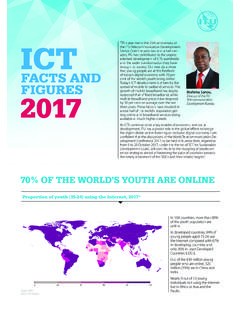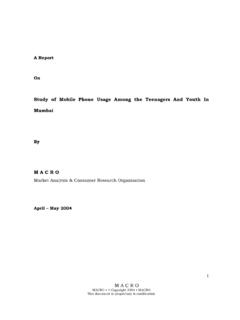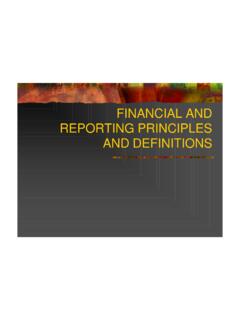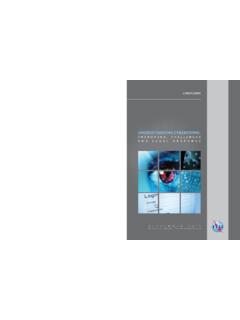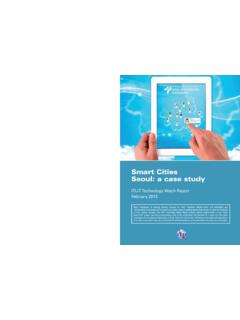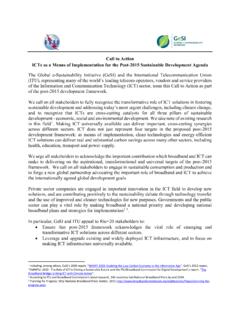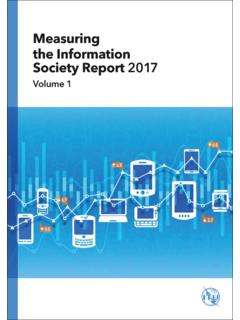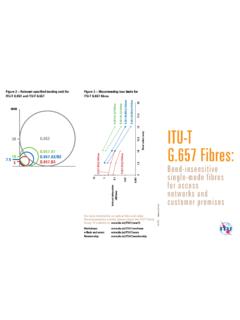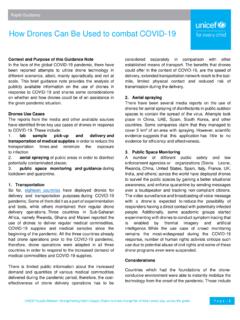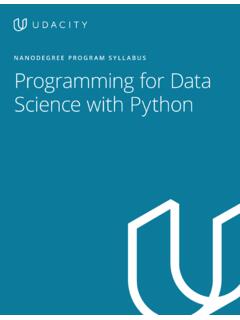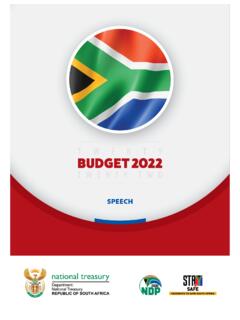Transcription of E-GOVERNANCE INITIATIVES – INDIA
1 E-GOVERNANCE INITIATIVES INDIA . The Government would implement a comprehensive programme to accelerate E-GOVERNANCE at all levels of the Government to improve efficiency, transparency and accountability at the Government- Citizen Interface. Hon'ble Prime Minister's Declaration on Independence Day - 15th August 2002. I ndia has been harnessing the benefits provided by the Information & Communication Technologies (ICT) to provide integrated governance, reach to the citizens faster, provide efficient services and citizen empowerment through access to information. The aim is to redefine governance in the ICT age to provide SMART GOVERNANCE. Several significant INITIATIVES have been taken at the Centre and the State level in this direction. A t the Central level, the government has extensively promoted the use of IT in managing its internal processes and has drawn up a Minimum Agenda of E-GOVERNANCE '.
2 Further Ministries /. departments have provision of 2 to 3 percent of their annual budgets to be spent on IT related activities. The government has enacted IT Act 2000 which provides legal status to the information and transactions carried on the net. S everal State Governments have also taken various innovative steps to promote E-GOVERNANCE and have drawn up a roadmap for IT implementation and delivery of services to the citizens on-line. The applications that have been implemented are targeted towards providing G2B, G2C and B2C services with emphasis on use of local language. The prominent sites where information can be accessed have been indicated at Annexure. An illustrative list with details of some significant E-GOVERNANCE INITIATIVES /. projects implemented is given below. 1. Project: Bhoomi Description: The Department of Revenue in Karnataka State has computerized 20 million records of land ownership of million farmers in the State.
3 Previously, farmers had to seek out the Village Accountant to get a copy of Record of Rights, Tenancy and Crops (RTC) a document needed for many tasks such as obtaining bank loans. There were delays and harassment. Bribes had to be paid. Today, for a fee of Rs. 15, a printed copy of the RTC can be obtained online at computerized land record kiosks (Bhoomi centers) in 177 taluk offices. This system works with the software called BHOOMI designed fully in-house by National Informatics Center, Bangalore. The Department of Information Technology, Govt. of INDIA has embarked upon a major programme to rollout Land Records Computerisation in several States of the country. End Users/Beneficiaries: Rural People State where Implemented: Karnataka Awards/Appriciation: Silver CAPAM award 2002. Project: e-Seva (electronic Seva). Description: Launched on the 25th of August 2001, electronic seva (e-Seva) is the improved version of the TWINS project launched in 1999, in the twin cities of Hyderabad and Secunderabad in Andhra Pradesh.
4 There are currently 36. eSeva centres spread across the twin cities of Hyderabad and Secunderabad and Ranga Reddy district, operating from 8:00 am to 8:00 pm every day and between 9:30 am and 3:30 pm on holidays. 70 centers are in operation at different municipalities covering thirteen districts. eSeva centres offer 118 different services like payment of utility bills/taxes, registration of births/deaths, registration of applications for passports , issue of births/deaths certificates, filing of Sales Tax returns, Trade licenses of MCH, B2C services like payments of Tata Teleservices, Reliance, sale of Airtel Magic cards. These services can be availed at any counter in the centre and at any place in the city. 21 more services like railway reservations, TTD services, bill payments of Airtel, Hutch etc. are in the pipe line. Though the e- Seva had a very lukewarm response from the citizens, the initiative has picked up tremendous confidence on the way and has so far netted a thumping collection of close to Rs 2,000 crore (February-end 2003).
5 From a meagre collection of Rs 43 lakh in August government has rolled out the project to other parts of the state, including rural areas like the West Godavari district. 2. End Users/Beneficiaries: Populace State where Implemented: Andhra Pradesh (Hyderabad and Secunderabad and Ranga Reddy district). ; ; Project: CARD. Description: The Computer-aided Administration of Registration Department - CARD in Andhra Pradesh is designed to eliminate the maladies affecting the conventional registration system by introducing electronic delivery of all registration services. CARD was initiated to meet objectives to demystify the registration process, bring speed, efficiency, consistency and reliability, substantially improve the citizen interface etc. Six months following the launch of the CARD project, about 80% of all land registration transactions in AP were carried out electronically.
6 Since 60% of the documents, Encumbrance Certificates (ECs) and certified copies relate to agricultural properties, the success of the CARD project has great benefit for the rural farming community. CARD is operational at 387 Sub- registrar offices in the entire state of Andhra Pradesh since 1998. End Users/Beneficiaries: Populace State where Implemented: Andhra Pradesh 3. Project: FRIENDS. Description: Fast, Reliable, Instant, Efficient Network for the Disbursement of Services is part of the Kerala State IT Mission. FRIENDS counters handle 1,000. types of payment bills originating out of various PSUs. The payments that citizens can make include utility payments for electricity and water, revenue taxes, license fees, motor vehicle taxes, university fees, etc. Firewalls safeguard data from manipulation. The application has provisions for adding more modules and for rolling back incorrect entries without affecting the database even at the user level.
7 One important feature of FRIENDS is a provision for adding more modules and a queue management system. End Users/Beneficiaries: Populace State where Implemented: Kerala Project: Gyandoot Description: The Gyandoot project was initiated in January 2000 by a committed group of civil servants in consultation with various gram panchayats in the Dhar district of Madhya Pradesh. Gyandoot is a low cost, self-sustainable, and community-owned rural Intranet system (Soochnalaya) that caters to the specific needs of village communities in the district. Thirty-five such centres have been established since January 2000 and are managed by rural youth selected and trained from amongst the unemployed educated youth of the village. They run the Soochanalayas (organised as Kiosks) as entrepreneurs (Soochaks); user charges are levied for a wide range of services that include agricultural information, market information, health, education, women's issues, and applications for services delivered by the district administration related to land ownership, affirmative action, and poverty alleviation.
8 Kiosks are connected to the Intranet through dial-up lines, which are soon to be replaced by wireless connections using CorDECT technology. The Soochanalayas have been equipped with Pentium multimedia colour computer along with dot matrix printers. The user interface is menu based with information presented in the local Hindi language and the features of the Gyandoot software are continuously being updated. 4. End Users/Beneficiaries: Rural People State where Implemented: Madhya Pradesh Awards/Appreciation: Stockholm Challenge Award 2002; CSI National IT Award CERT-IN (Indian Computer Emergency Response Team). Description: The Indian Computer Emergency Response Team (CERT-In). has been established by the Department of Information Technology to be a part of the international CERT community. It has a mandate to respond to computer security incidents reported by the entire computer and networking community in the country alongwith creating security awareness among the Indian cyber-community.
9 "To enhance the security of INDIA 's Communications and Information Infrastructure through proactive action and effective collaboration.". CERT will: Serve as a central point for responding to computer security incidents and provide a reliable, trusted, 24-hour referral contact for emergencies. Increase awareness and understanding of Information security and computer security issues among Indian cyber user community. Alert the community on latest security threats in the form of advisories, vulnerability notes and incident notes. Serve as a coordination center among organisations to solve computer security issues. Project: VidyaVahini Description: This portal provides the opportunity for schools, teachers and students all across the nation, to express and share their creative and academic potential via the internet. The portal aims at creating such an environment by providing facilities for Content Development, Content Deployment and collaboration.
10 5. Shiksha INDIA is a non- profit organization launched in December 2001 to equip schools with the 5 Cs: Computers, Connectivity, Coaching (teacher Training), Content and models of Commercial sustainability. Its mission is to spread better education, uniform quality of education across INDIA to develop their creativity and problem solving skills. By providing computer literacy, Shiksha strives to increase the earning capacity, reduce information arbitrage in rural INDIA and promote entrepreneurship. Shiksha INDIA is working in partnership with The Ministry of Information Technology in the project Vidya Vahini and Ministry of Human Resources under the CLASS scheme which aims to connect schools (approximately 20 million students) across the country in next five years. Controller of Certifying Authorities (CCA). Description: Controller of Certifying Authorities (CCA) as the Root Authority certifies the technologies,infrastructure and practices of all the Certifying Authorities licensed to issue Digital Signature Certificates.
